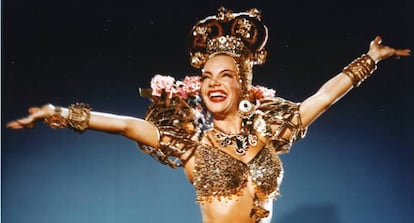Rio de Janeiro tries to make up with Carmen Miranda
After a decade, the city where the singer’s career took off is reopening the museum that displays her costumes, photos and famous tropical headdresses, a departure from Brazil’s indifference towards its biggest international star

Singer, actress and global icon, Carmen Miranda was the first South American artist to achieve stardom in the United States. She became the best-paid woman in Hollywood. Her impossible fruit headdresses, the frenetic movement of her eyes and the graceful movement of her hands and hips conquered half the world, but Brazil has always been indifferent to her. A museum of her life opened in Rio de Janeiro in 1976, but it has been closed for ten years, due to a mixture of institutional neglect and budget cuts. Until now. On August 4, the eve of the anniversary of the artist’s death, it will reopen with the hope of restoring the relationship between Miranda and the land that saw her grow up, after she arrived as an infant with her family of Portuguese emigrants.
That is what César Balbi, director of the center since its inauguration, hopes. After meandering between painters and masons to check the last touches, he sits down to talk about the iconic figure: “The relationship of Brazilians with Carmen Miranda is pure ignorance, but in recent years they’ve started to take more interest in her, to realize that she was above all a singer, not an actress who went to the U.S. and became a caricature,” he says. After a decade in storage, her dresses, jewelry, shoes and, above all, headdresses, will once again shine before the visitors. The collection, mostly donated by Miranda’s family, is made up of almost 4,000 objects. 121 will be exhibited at once.
The small concrete building, the work of the modernist architect Affonso Reidy, is like a small circular jewelry box. It sits in the Flamengo park. A short distance away, just across the Botafogo inlet, is the Urca casino, now in ruins, the scene of some of the singer’s most memorable moments. In 1940, after a successful first performance in the United States, she sang South American Way before an audience made up of the elite and the senior officials of the nationalist government of Getúlio Vargas, who at the time was flirting with Nazism. She was received with coldness and a wave of criticism, but she responded shortly with the ironic lyrics of Disseram que voltei americanizada [They said I came back Americanized], in which she mocked those who said she no longer had rhythm. After that bumpy return home, Carmen headed back to the U.S., never to return. She established herself as a global star: 14 films earned her the nickname Brazilian Bombshell, despite the fact that she embodied Latino characters without a clear identity — a blend of tropes catered to the taste of the American viewer, which worked well at a time when the government of Franklin D. Roosevelt launched the Good Neighbor policy.
It is not that Miranda was not a prophet in her land. She was adored in Brazil. She functioned as a bridge between the popular and the elite, and her premature death at the age of 46 shocked the people. She died in Beverly Hills, but her burial in Rio was an event that brought tens of thousands of Brazilians to the streets. But her legacy did not age well. Caetano Veloso, one of the fathers of Tropicalismo, a movement that was nourished by Miranda’s aesthetics and philosophy, summarized it in a famous article for The New York Times: “Carmen Miranda was, first, a cause for both pride and shame, and, later, a symbol that inspired the merciless gaze we began to cast upon ourselves.”
For a long time, Miranda was reduced to a bunch of Technicolor bananas, ignoring her enormous talent, her strong personality and, above all, her creativity and nose for success. Her classic Bahian look, for example, was not imposed by Hollywood to force an exotic image. She appeared for the first time in a 1938 Brazilian film, Banana da Terra, in which Miranda, directed by Dorial Caymmi, wore the traditional clothing of Bahian matriarchs. She replicated the successful look ad nauseam, but always giving it a different spin. Miranda never repeated costumes. She had learned to sew as a child and worked in a hat shop, and she herself created her spectacular headdresses. She managed to place Portuguese in American productions, and she exported the samba and the marchinchas of Carnival. The historian Ruy Castro, author of a dense biography that in 2005 helped to resurrect her figure, considers her the inventor of modern Brazilian music.
Despite all her conquests, today, would the artist survive the trial of the internet? Would she be quickly accused of cultural appropriation? To contribute to whitewashing an eminently Black root music? The director of the museum does not believe that Miranda would be “cancelled.” He goes a step further: he compares her to Anitta, the most successful Brazilian singer today, another example of globalization and export of the country’s rhythms. “The carioca funk that Anitta sings is what Carmen’s samba was in her time, the music of Blacks, of the poor in the peripheries,” he says. Anitta herself has recognized on several occasions that Miranda is her main influence, emulating her predecessor’s iconic looks in her concerts. Despite these winks, and the fact that she has lived on in drag culture and in the LGTBQ+ community, Miranda has not received the recognition she deserves in Brazil, Balbi says. In Los Angeles, she has a star on the Walk of Fame, but in her country, the cinema industry was never interested in her life.
Now, in addition to the small museum, another, more ambitious project on the horizon will give Miranda a place. The monumental Museum of Image and Sound (MIS), dedicated to the country’s musical and audiovisual production as a whole, is expected to open its doors on Copacabana Beach in November 2024, after years of construction delays. It will have a space dedicated to the artist, where more than 90 original pieces from her endless personal archive will be exhibited. But if there is a place where Miranda lives and resists despite everything, it is Carnival. In February, the homemade costumes with their tropical headdresses will once again color the streets. The cariocas, lost among the troupes of musicians, will once again sing, under the same scorching sun as every year, the verses of her 1930 hit, Taí: “Eu fiz tudo para você gostar de mim, ô meu bem não faz assim comigo não, você tem, você tem que me dar seu coração” (I did everything for you to love me, oh honey, don’t do that to me, you have to give me, you have to give me your heart.)
Sign up for our weekly newsletter to get more English-language news coverage from EL PAÍS USA Edition
Tu suscripción se está usando en otro dispositivo
¿Quieres añadir otro usuario a tu suscripción?
Si continúas leyendo en este dispositivo, no se podrá leer en el otro.
FlechaTu suscripción se está usando en otro dispositivo y solo puedes acceder a EL PAÍS desde un dispositivo a la vez.
Si quieres compartir tu cuenta, cambia tu suscripción a la modalidad Premium, así podrás añadir otro usuario. Cada uno accederá con su propia cuenta de email, lo que os permitirá personalizar vuestra experiencia en EL PAÍS.
¿Tienes una suscripción de empresa? Accede aquí para contratar más cuentas.
En el caso de no saber quién está usando tu cuenta, te recomendamos cambiar tu contraseña aquí.
Si decides continuar compartiendo tu cuenta, este mensaje se mostrará en tu dispositivo y en el de la otra persona que está usando tu cuenta de forma indefinida, afectando a tu experiencia de lectura. Puedes consultar aquí los términos y condiciones de la suscripción digital.
More information
Archived In
Últimas noticias
Most viewed
- David King, chemist: ‘There are scientists studying how to cool the planet; nobody should stop these experiments from happening’
- Reinhard Genzel, Nobel laureate in physics: ‘One-minute videos will never give you the truth’
- Mexico completes its trade shift with the entry into force of tariffs on China and countries without trade agreements
- Oona Chaplin: ‘I told James Cameron that I was living in a treehouse and starting a permaculture project with a friend’
- Sinaloa Cartel war is taking its toll on Los Chapitos










































